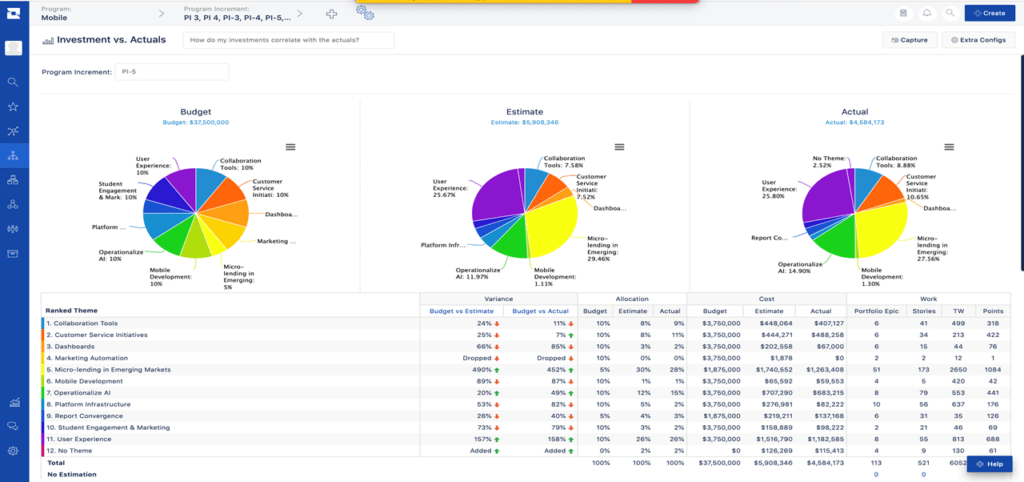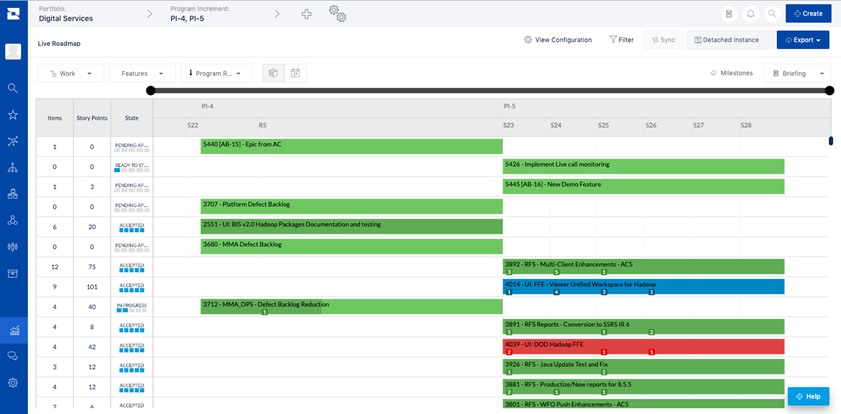Aligning Portfolio Management with the Rest of the Enterprise
In a previous post, we introduced you to Jira Align — formerly known as AgileCraft — the newest addition to the Atlassian suite of solutions. We’re extremely excited about this powerful tool and its seamless integration with Jira and other applications so many of our clients rely on. So, we’re diving a bit deeper into Jira Align with a series of four articles focused on some of the key user roles:
- Product Manager
- Program Manager
- Portfolio Manager
- Executive
In each case, we’ll explore the day-to-day challenges these individuals often face during their enterprise agile journey, and how Jira Align provides satisfactory solutions to those problems.
The Portfolio Manager’s Role
The portfolio manager’s role is defined by broad oversight of multiple programs and the product teams that make them up. They need to coordinate the activities of these programs to keep them in line with the portfolio’s and the larger enterprise’s strategic objectives. Budgeting and resource allocation are a huge part of this role, while communication and big picture thinking are vital skills.
What is a portfolio manager?
Agile coach, author, and consultant, Luis Goncalves defines agile portfolio management this way:
“Agile portfolio management makes certain that a business can supply their clients with the value they deserve for their investment. A responsible portfolio manager or team knows and embodies the principles of the agile method while also taking into account the factors essential to the success of the company’s projects.”
Likewise, we’ve previously covered portfolio alignment, outlining why effective portfolio management ensures “that when the organization invests resources in building out this portfolio, they will be making progress toward meeting strategic objectives they have already identified as beneficial for the organization.”
It’s the portfolio manager’s job to establish and maintain that vital connection and continually communicate with program managers, product managers, tech executives, and all other impacted shareholders.
What does a portfolio manager do?
Since they’re often removed from most of the day-to-day operations happening at the team level, the bulk of the portfolio manager’s daily work consists of monitoring data provided by product and program managers and using that data to guide current and future strategic direction for the entire portfolio.
At the same time, the portfolio manager needs to stay abreast of overarching organizational strategy and goals to ensure their portfolio is producing value commensurate with the investment the enterprise has made. And, looking ahead, to make necessary recommendations or requests for future investment that can be backed up by the data.
The portfolio manager as backstage coordinator
In the last article, we described the program manager as a juggler keeping multiple objects in the air at all times. In this case, however, we need to take a look “backstage” where we find the portfolio manager acting more as a coordinator and director that keeps “the greatest show on earth” performing at its best. They don’t generally need to interface with customers, and in most cases they won’t work directly with the C-suite either. Yet, their work behind the scenes is absolutely vital to the smooth operation of the agile enterprise.
We can imagine them with a clipboard and a headset, running around backstage to make sure the performers coming out next are ready to go, giving timely reminders to lighting operators, stopping to straighten a clown’s wig, and regularly pausing by the curtain to peek out, just to make sure the show is going well and the audience is having fun. If something needs to be changed at the last moment, he keeps a cool head and makes the necessary decision quickly.
Without the portfolio manager’s big picture view, the managers and teams they support could easily end up working hard toward the wrong goals. Or, they could do a spectacular job accomplishing an organizational goal, but spend so much time and money doing so, their success evaporates. A successful portfolio manager can maintain the autonomy and value of each team under his control while guiding them skillfully toward success on enterprise terms.
And, as we’ll see below, the clipboard and headset are key to making that happen.
The Challenges Facing Portfolio Managers Today
The challenges facing portfolio manager mirror those facing the program managers they support. But, of course, these challenges have even larger ramifications at the portfolio level and to the enterprise as a whole.
Disconnected strategies
The portfolio manager is intimately familiar with the overarching enterprise business goals guiding organizational strategy. But, making sure those strategic goals filter all the way down to the developers and teams doing the work can be a challenge in itself.
In addition, the portfolio manager needs to establish budgets and strategic themes for all the programs and products within the portfolio and determine where each falls in the prioritized portfolio backlog. On a human level, this prioritization can mean certain preferred projects or favorite tasks need to be eliminated or deprioritized to keep the teams aligned with enterprise strategy, which can also be a difficult responsibility.
Finally, if organizational strategy changes — always a possibility — it’s up to the portfolio manager to realign their portfolio with the new direction coming down from above. This can sometimes cause confusion, conflict, or frustration, not to mention significant waste of time and money, especially when strategic goals are unclear.
Prioritizing and decision making on the fly
Much like the product and program managers, the portfolio manager needs to make important decisions every day, perhaps impacting hundreds of people and involving millions of dollars of enterprise funds. It would be ideal if accurate, up-to-date data was always on hand.
But, many portfolio managers find the opposite is more common. In the worst cases, that can mean on-the-spot decisions to adjust priorities, reallocate resources, or hit pause on an entire program, all based on gut feelings and best guesses.
Trusting the program and product managers
Trust is a vital component of any successful agile workflow. The portfolio manager has far too much on their plate to try to micromanage any aspect of what goes on in the individual programs and product teams making up his portfolio. Instead, they need to work closely with product and program managers, relying on them for accurate data and sound advice. In turn, they need to trust those managers to communicate with their teams effectively and trust the teams to follow through on the tasks as they appear in the portfolio backlog.
How Jira Align Helps Portfolio Managers
Jira Align includes a number of powerful features designed specifically to solve these common challenges for portfolio managers in the enterprise environment. Continuing our illustration from above, the solution serves as the headset and clipboard the backstage coordinator relies on to communicate and collaborate effectively with the most up-to-date and accurate information available.
Consolidated data
The most valuable aspect of Jira Align is the way it makes all pertinent information at every level of the enterprise easily accessible and actionable.
Within Jira Align, each level has its own dedicated “room” that contains the core suite of reports and views that individual is likely to need most often. In the portfolio manager’s room, we find these vital sources of real time data and analysis at their fingers:
- Strategic / financial alignment – big picture financial data, viewed through the lens of enterprise strategy
- Demand intake and forecasting – allowing balanced, coordinated intake with what if analysis for strategic, prioritized decision making
- Investments vs. actuals – the foundation for all strategic budgeting decisions for WIP and for future planning
- Value stream optimization – filtering all deliverables, resource allocation, and budgeting data through value streams
- Portfolio agile metrics – consolidated burndown and burnup views with numerous filters to drill down from programs to epics, teams, and individuals.
- Portfolio WIP – constant visibility into where work stands across all programs and products
Additionally, each report or view offers the opportunity to drill down to the program and product levels to offer granular context to every data point and trend on display. And, all users have access to over 200 reports, so even if what they need isn’t already housed in the portfolio room, it’s just a click away.
With this real time reporting always on hand, portfolio managers never need to make decisions based on gut feelings and guesswork. They can easily spot discrepancies or unexpected bottlenecks at any level and address them quickly to keep the portfolio moving ahead toward success.
Process automation
The wealth of information available within Jira Align is further augmented by automation capabilities that can remove much of the project management busy work from managers’ plates, freeing them up to focus more on strategic analysis and planning.
For example, the portfolio backlog housed in Jira Align utilizes easy drag-and-drop functionality for prioritization. Users can filter the backlog by program, strategic driver, owner, process step, WSJF, Value Scores, story points, and more. Then, as program and product managers further build out the backlog with tasks and work commences, the entire backlog dynamically updates across the entire solution, no matter what view or filter you’re using.
As work progresses, if the strategy changes or initiatives need to be reprioritized, Jira Align users do not have to go in and manually reorder features accordingly. They can choose to “Pull Rank” to automatically rearrange features respective to the new priority assigned to the parent item. Everyone always has access to the very latest backlog along with all the associated data on tasks that are in progress or already completed.
For more information about Jira Align and how it can be used to enhance portfolio management, watch our free webinar, Align to Strategy and Portfolio Management with Jira Align.
In the next article in this series, we’ll explore the tech executive role and how Jira Align helps make their lives easier.





